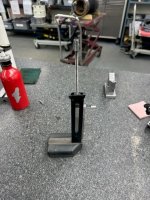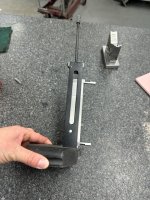Milling man
Cast Iron
- Joined
- Aug 6, 2021
- Location
- Moscow, Russia
I’ve used a lot of air gauges, but never tried to DIY one, that’s an interesting idea. One word of caution, you can make the read value on an air gauge change a tenth with changes in surface roughness, so consistency is key as always.
If you make this device yourself, it makes sense to measure not pressure, but air flow. The flow meter is easy to make yourself - it is a transparent tube with a conical bore. The taper is selected empirically, but it should be very small, about 1:50-1:100. The tube is vertical, the smaller diameter of the cone is from below, the air supply is also from below. There is a ball in the cone, the material of the ball is also selected experimentally. Obviously, with a very small taper, even a small change in flow rate will lead to a very large change in the position of the ball.
This is exactly what our old turner described to me. He worked a lot with lapping operations, and the holes had to be measured with an accuracy of about 0.5 microns. Such a thing quite allowed to do this, but there was one rule - the gap between the pin and the measured ring should always be approximately the same. That is, it is impossible to measure rings with a diameter of 20-21 with one pin with a diameter of 20.




 Mabe a go, no go stack? Other than that the half-rounds are just awesome
Mabe a go, no go stack? Other than that the half-rounds are just awesome 
